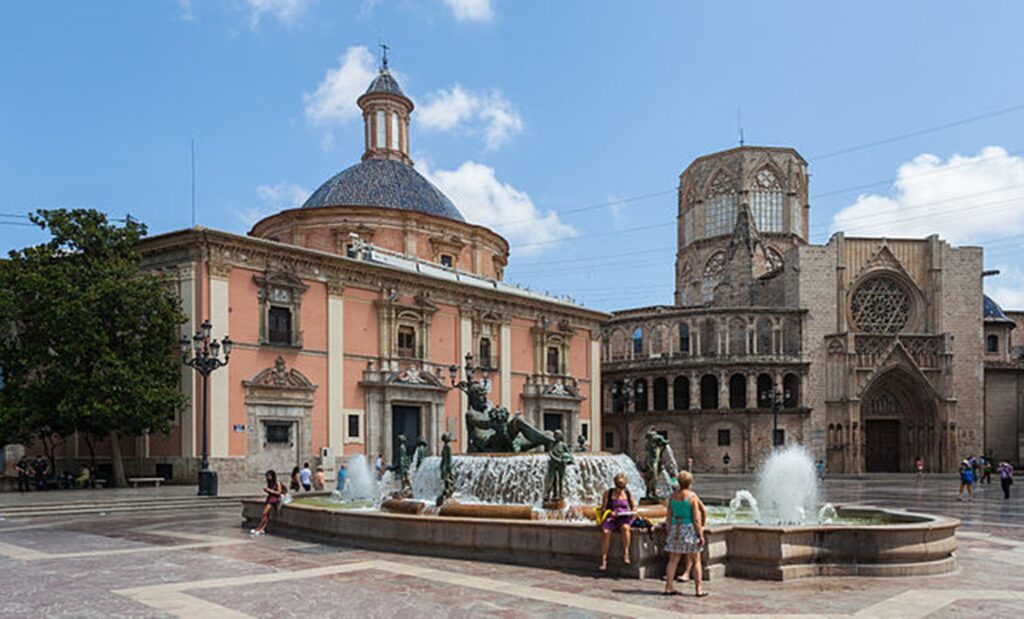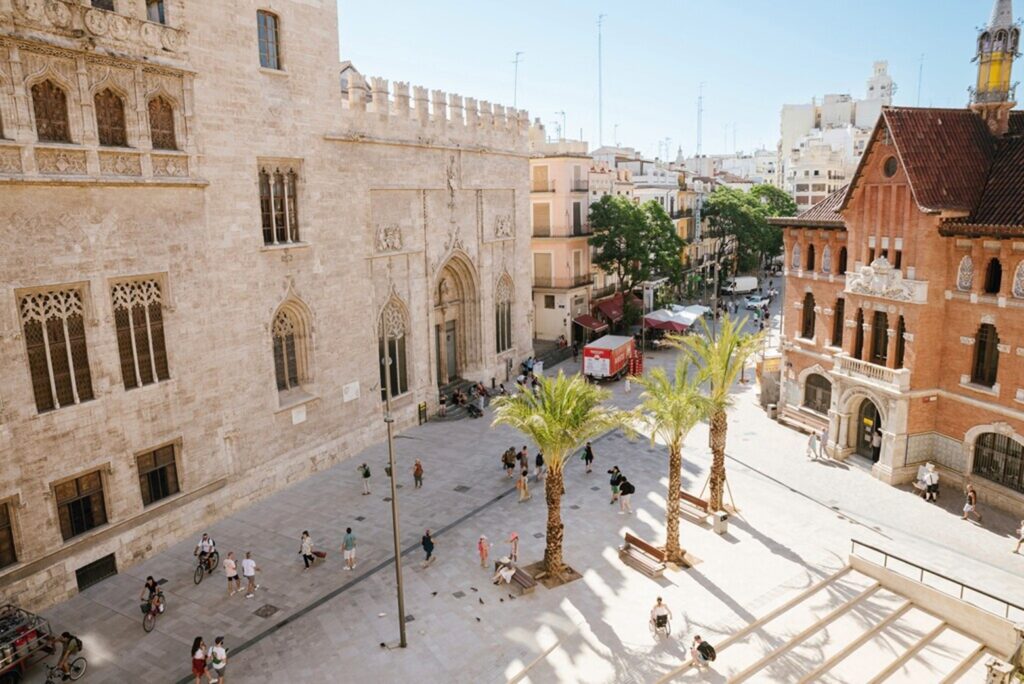Valencia is Spain’s third-largest city, after Barcelona and Madrid. It’s a beautiful historic city filled with stories.
This city has enough surprises to charm visitors.
You get to see urban beaches, advanced arts complexes, and unmatched parties around the Iberian Peninsula.
This amazing city hosted some of the best restaurants. L’Hamadríada was one of them.
L’Hamadríada used to be a relaxing spot in Valencia’s old El Carmen neighborhood.
It had this warm and quiet charm that made you feel at home.
People usually come for a relaxed feel but stay for the food.
One of their main dishes was duck foie gras with apple and caramelized onions, finished with a red wine sauce.
They also served different kinds of rice every day, putting their own unique touch on Valencia’s famous rice tradition.
This made diners happy. So, it wasn’t just a place to eat—it was where locals and visitors gathered for good food and a relaxed evening.
Now that it’s closed, it leaves behind a quiet space in the city’s food scene.
In this post, I will walk you through how it all began, why it’s closed down, and the historical settings around Restaurant L’Hamadriada in Valencia.
How It All Started
The Restaurant L’Hamadríada began operation in the old part of Valencia, in a narrow alley beside an ancient cistern.
Two local chefs came together to set up a place to offer visitors something different in that part of Valencia.
As their restaurant kicked off, the dream was simple: to serve mixed fresh market foods with a warm, friendly feel.
The chefs opened the doors around 2008, eager to share their kitchen reality with neighbors and visitors.
From their menu, you could tell they aimed to maintain tradition with a touch of surprise to go with the Mediterranean dishes.
One of their major menus was to serve the famous paellas in Valencia. They made it stand out by serving it daily with creativity.

Another menu you couldn’t miss was their signature dish: duck foie gras with sweet apple slices and caramelized onions.
Each dish showed their care for quality ingredients from local markets.
It didn’t take long for the restaurant to become one of the talk of the town for tasty food and a comfortable spot.
Without surprise, not too long, guidebooks like Lonely Planet listed L’Hamadríada as a top pick in the city.
Among the many reviews from their customers, what stood out was their friendly service and the honest, home-like cooking.
So, because of where it’s located, the restaurant felt like a secret spot that made every meal feel special.
From its first days, it stood out for its love of simple, well-made dishes.
That helped make L’Hamadríada a real success.
Why L’Hamadríada in Valencia Closed Down
Now, to the full story of why L’Hamadríada in Valencia had to close.
First, its online home disappeared. L’Hamadríada’s official website is now a parked Namecheap page, so it’s not active anymore.
If you visit their website, hamadriada.com, you will see no menu, no photos, and nothing.

That usually means a business has shut down for good.
The business even vanished from most booking and review sites with no updates or notices from the owners.
Then came the pandemic shutdown. According to EL PAÍS article, in January 2021, the authorities in Valencia ordered every bar and restaurant to close for two weeks to slow COVID-19.
With no dine-in allowed, tables stayed empty, and kitchens went quiet, except for those who could deliver takeouts.
It’s fair to say the COVID-19 pandemic affected the city’s tourist attractions.
Before the pandemic, Spain welcomed 84 million visitors in 2019. But in 2020, that number crashed by 77 percent to just 18.9 million.
That simply meant far fewer people strolling El Carmen’s streets and far fewer meals served.
So, in that time, Valencia lost 887 hospitality venues since 2019, and many places have shut for good.
As if that wasn’t enough, In October 2024., a DANA (Depresión Aislada en Niveles Altos) heavy rainfall hit Valencia hard.
Tours in Valencia wrote in detail about this tragic flood occurrence in Valencia.

Torrential rains filled streets, which caused severe damage and loss of lives and sent locals indoors.
Even when restaurants reopened, many diners stayed away for safety and cleanup.
On top of that, costs kept rising.
According to YCharts, by March 2025, prices for hotels and restaurants were up 4.2 percent from a year earlier, squeezing already tight budgets.
Landlords in the old city also hiked rents. Some reports from Valencia Life say that it is as much as 37 percent in the center. This made it harder for small spots to pay the bills.
When we consider all of these, we can see how this might have affected L’Hamadríada in Valencia.
More discomfort was still about to hit local businesses, including L’Hamadríada, as the new tourist rules set didn’t help either.
Cadena SER reported that the city capped holiday flats at 15 percent of ground-floor shops to protect local businesses, reducing the extra income some restaurants had counted on from nearby visitors.
Meanwhile, the Financial Times said the regional government threatened fines of up to €600,000 for unlicensed short-term rentals.

This is another blow to the “Airbnb economy” restaurants sometimes relied on.
Finally, help came too late. After the flood, 1,400 bars and restaurants were hit, yet many still wait for promised aid.
Over 40 percent of those damaged spots haven’t even had their insurance checks yet.
All these issues I’ve mentioned, like no website, COVID closures, fewer tourists, floods, rising costs, strict rules, and slow aid, made it impossible for L’Hamadríada to stay open.
Historical Setting around the L’Hamadríada in Valencia
The L’Hamadríada’s spot in El Carmen is worth writing about because of how it’s surrounded by centuries of Valencia’s story.
You could see cathedrals, towers, and winding alleys everywhere.
The neighborhood where the restaurant is located is El Carmen. It’s a place where the past and present meet.
According to Wikipedia, El Carmen is one of the six old-town neighborhoods in Valencia’s Ciutat Vella, or Old City.
It grew up between a very old Muslim wall to the east and a later Christian wall to the west. So, you could still feel those old defenses today in its streets.
Today, you’ll find narrow lanes, art-filled plazas, and a mix of tiny cafés and tapas bars that feel straight out of history.
Walking on this street will make you feel like you’re watching Valencia’s past.
Within a few turns, you could be walking past a Gothic church, an old convent, and other attractive scenes like street murals.
You can see why locals and tourists love to visit the area and eat there.
Now, let’s look at the landmarks in the neighborhood. Every corner has a story to tell.
1. Plaza de la Virgen & Valencia Cathedral

According to Hospes, when you list the city’s most iconic and beautiful squares, Plaza de la Virgen in Valencia will be one of them.
You’ll find it at the center of the urban area, in a location where the Roman Forum was once situated.
It’s Just a five-minute walk from El Carmen’s heart.
The Plaza de la Virgen, framed by the Basilica of the Virgin of the Helpless, was built in the 17th century.
It is connected to the Valencia cathedral by a corridor, and only the religious people who guard the temple can access it.
If you time it right at sunset, the sunlight bounces off the cathedral’s Gothic façade and washes the square in gold.
2. La Lonja de la Seda (Silk Exchange)

From the center of El Carmen, head east through Carrer de la Llotja for about ten minutes, and you’ll reach the Lonja de la Seda.
It’s a 15th-century Gothic masterpiece and a UNESCO World Heritage site.
When you walk up to this big, beautiful building, you’ll first notice how fancy it looks.
The outside is covered with detailed stone designs and tall towers that show how rich and powerful the city was back then.
When you step inside, the main hall feels huge. The ceilings are super high, and the big stone columns make it feel like you’re standing inside a giant ship.

That was on purpose—because Valencia used to be known for its sea trade. They wanted the building to remind people of ships and the ocean.
And as you look around, you’ll see lots of fancy decorations and pretty paintings.
These show how important the silk business used to be in Valencia.
3. Torres de Serranos & Torres de Quart

You’ll find Torres de Serranos at the northern edge of El Carmen. Its towering city gates date back to the 14th century,
This amazing center is about 600 meters from where L’Hamadríada lived.
A little further west, the twin Torres de Quart guard the old moat and mark where the city once kept watch over incoming travelers.
Final Thoughts
L’Hamadríada in Valencia was one of its kind. But as they often say, “Good things always come to an end.”
The restaurant brought many memories to locals and tourists during its time of operation, mainly because of its location.
Imagine sitting at your table, hearing faint laughter from a nearby plaza outside, and hearing the chime of church bells.
That’s the charm here: you’re not just tasting good food. You’re soaking in history and living the story of El Carmen.























